Small businesses make daily trade-offs about where to spend their limited time and money on marketing.
Some double down on social ads, others rely on reviews and referrals, and many are experimenting with AI tools for the first time.
But until now, there’s been little data on how these decisions are actually made across the small business landscape.
That’s why we ran the State of Small Business Marketing 2025 survey. Our goal was to capture how business owners and managers allocate budgets, choose channels, measure results, and respond to new technologies.
We also wanted to understand how reputation and reviews fit into the bigger picture of customer acquisition and growth.
Methodology
The data in this report comes from an online survey conducted through the Pollfish platform on September 25, 2025.
- Sample size: 400 respondents
- Audience: U.S.-based small business owners and managers of local businesses with employees
- Screening criteria: Only respondents who own or manage a local business with employees were included
- Questionnaire: 15 closed-ended questions, covering strategy, budgets, marketing channels, measurement, challenges, reviews, tools, AI, and outlook
With the survey complete, the results provide a detailed look at how small businesses are approaching marketing today. The sections that follow highlight the key findings.
1. Most Small Businesses Have a Written Marketing Plan
Nearly three in four small businesses (73.5%) report having a detailed, written marketing strategy that they actively use. Another 25% operate with informal guidelines, while only 1.5% admit to having no plan in place at all.
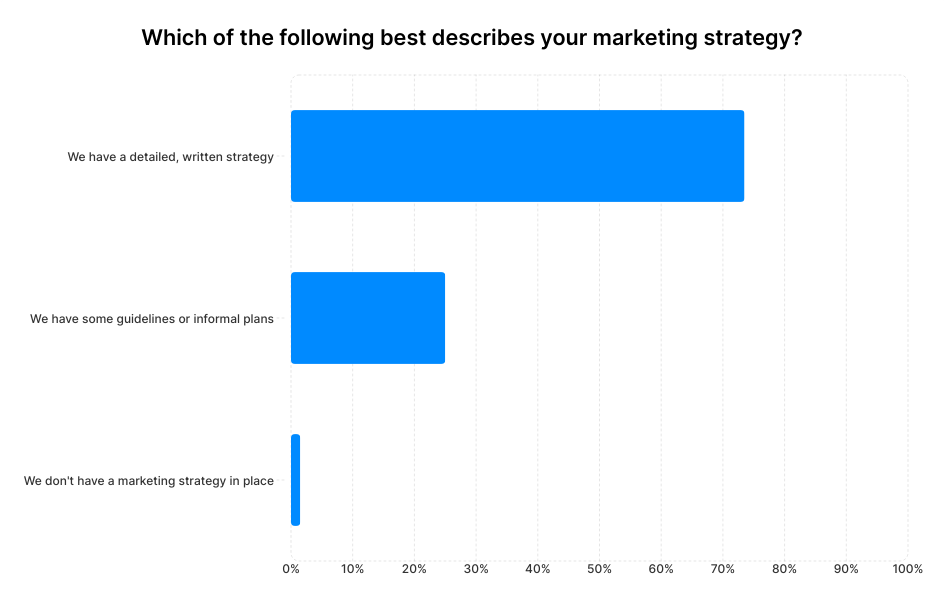
This suggests that marketing maturity among small businesses is higher than expected.
Many owners recognize the need for structure, though the gap between “guidelines” and “detailed strategy” may represent a missed opportunity for consistency and accountability.
Why It Matters
Without a formal plan, marketing can become reactive and inconsistent.
Businesses that operate only on informal guidelines often struggle to align tactics with broader goals, leading to wasted spend and missed opportunities.
Over time, this lack of structure can also make it harder to measure results, refine strategies, and build sustainable growth.
Recommendation
Small businesses should document their marketing strategy in writing.
Even a short, one-page plan is better than nothing, as it provides clarity and a reference point for decisions.
What matters most is that the plan ties directly to revenue goals, ensuring that every campaign and channel choice supports measurable business outcomes.
A simple written strategy also makes it easier to track progress, adjust when needed, and keep everyone aligned.
2. Marketing Is Still Mostly Owner-Driven
In 59% of small businesses, the owner is still the primary person responsible for marketing. Only 29% rely on an in-house team, while 8% use a marketing agency.
Fewer than 2% depend on freelancers or consultants.
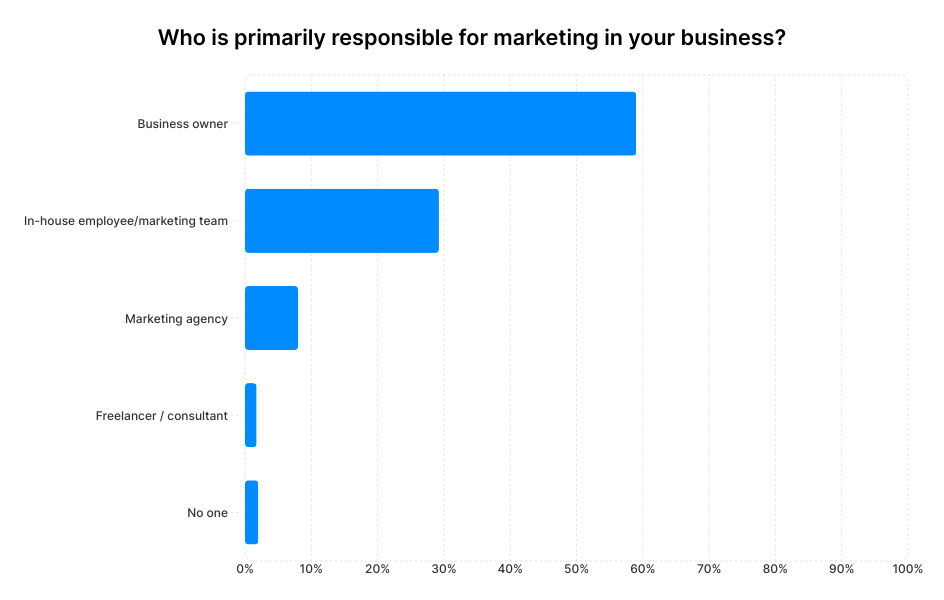
This underscores how marketing remains a founder-led responsibility for most local businesses.
While this may keep costs down, it can also limit scalability and sophistication compared to businesses that rely on dedicated teams or external expertise.
Why It Matters
When owners juggle marketing alongside operations, customer service, and finance, marketing often takes a backseat.
This can stall growth and lead to a reliance on short-term tactics instead of long-term strategy.
Over time, the lack of consistent focus can make it harder to build brand recognition, nurture loyal customers, and compete effectively against businesses with dedicated marketing resources.
Recommendation
SMBs should consider delegating marketing, either by hiring a part-time marketer, partnering with an agency, or using automation tools to free up owner time.
Offloading even a portion of marketing work allows owners to focus on operations and customer experience, while ensuring campaigns are executed consistently.
Over time, this shift can also bring more expertise and structure to marketing, helping the business grow beyond the limits of the owner’s bandwidth.
3. Most Businesses Adjust Their Strategy Monthly or Weekly
Marketing strategies are not static documents. Nearly 40% of respondents adjust their plans monthly, and 30% make changes weekly.
Just 3% review strategies annually, and less than 1% rarely adjust them at all.
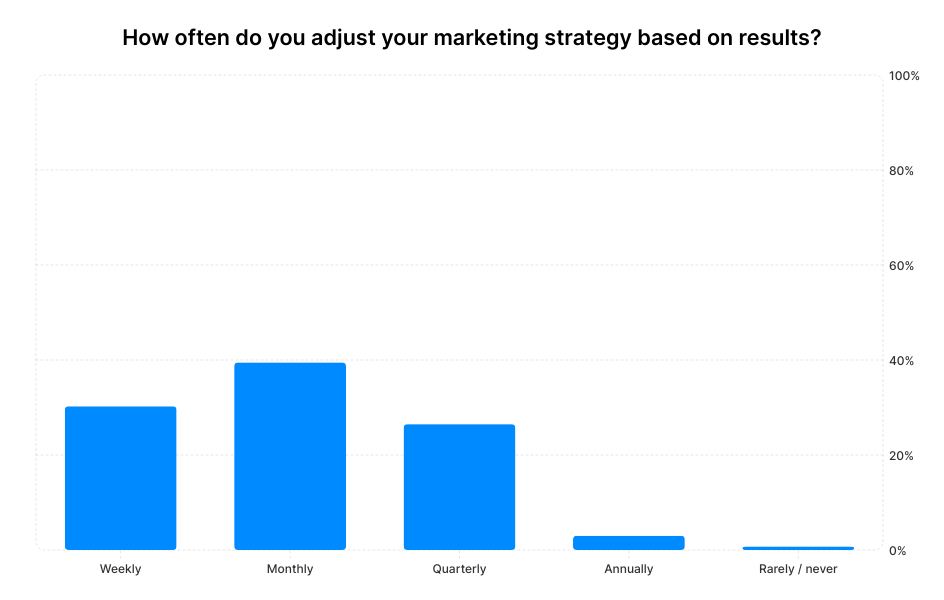
This adaptability highlights small businesses’ responsiveness to results and changing conditions.
At the same time, frequent changes may indicate reactive adjustments rather than long-term strategic planning.
Why It Matters
Adjusting too often can prevent campaigns from gaining traction, while adjusting too rarely risks missing shifts in customer behavior.
Striking the right balance is essential for getting a positive return on investment (ROI).
Regular reviews allow businesses to stay agile without falling into reactive decision-making, ensuring that changes are based on meaningful data rather than short-term noise.
Recommendation
Businesses should set clear performance benchmarks and review them on a set schedule (e.g., monthly for tactical campaigns, quarterly for overall strategy).
This helps prevent constant reactive changes while still keeping the strategy aligned with results.
Establishing regular review cycles also creates consistency, making it easier to identify which tactics are genuinely working and which need to be adjusted, rather than chasing the latest trend or short-term spike.
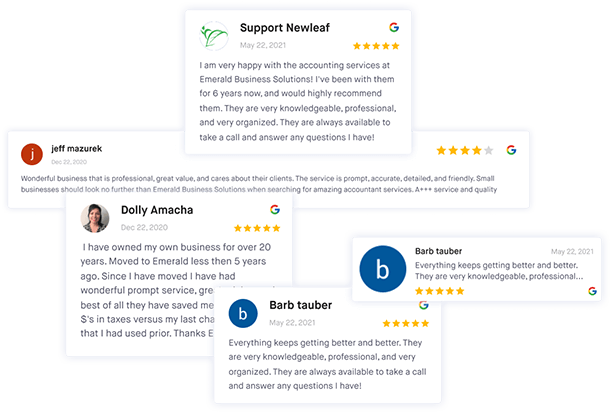
Manage online reviews with ease
Monitor, manage, and get more online reviews for your business with ReviewsOnMyWebsite.
4. Nearly Half Spend 6–10% of Revenue on Marketing
When asked about marketing budgets, the largest share of small businesses (around four in ten) dedicate 6–10% of their revenue to marketing.
About one-third spend more than 10%, while a much smaller share report spending less than 2%.
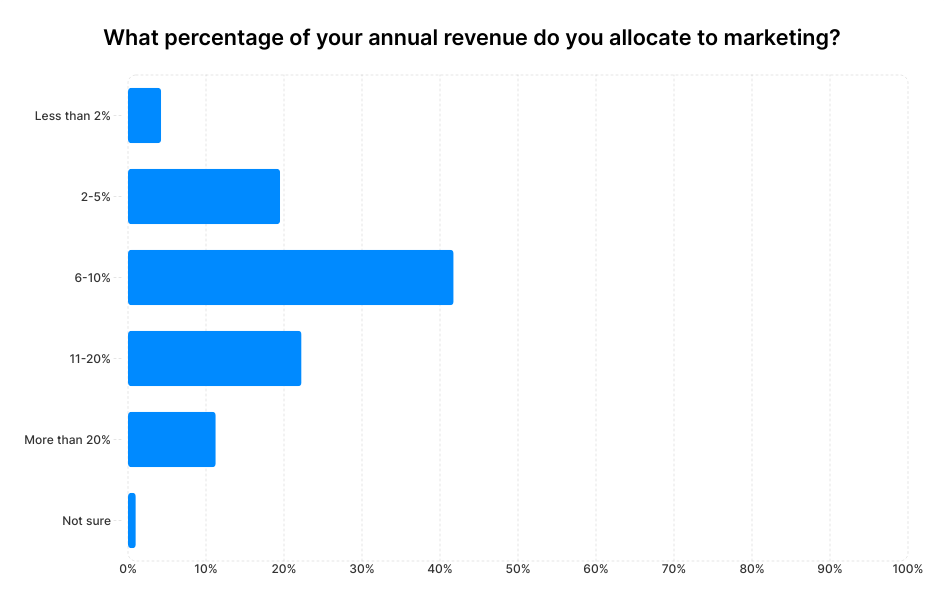
Overall, the data shows that most SMBs are committing meaningful resources to growth, even at smaller scales. Those that underinvest risk falling behind in competitive markets.
Why It Matters
Marketing spend is one of the clearest indicators of growth intent.
Underinvestment can leave businesses invisible online, while overspending without strategy risks wasted budgets.
Finding the right level of investment helps ensure that every dollar contributes to measurable outcomes, whether that’s driving new leads, retaining existing customers, or strengthening brand presence.
Over time, consistent and well-aligned spending builds a competitive edge that one-off splurges or minimal budgets cannot achieve.
Recommendation
Benchmarking against peers in the same industry and size category helps small businesses set more realistic marketing budgets.
Without a point of comparison, it’s easy to either overspend in areas that don’t drive results or underspend in ways that limit visibility and growth.
By understanding how similar businesses allocate resources, owners can make more confident budgeting decisions and ensure their investments stay competitive in their market.
5. Social Media Ads Dominate Marketing Budgets
Social media advertising is the top spending category, with 44% of respondents saying it receives the largest share of their marketing budget. Google Ads (17%) and SEO (10%) trail far behind.
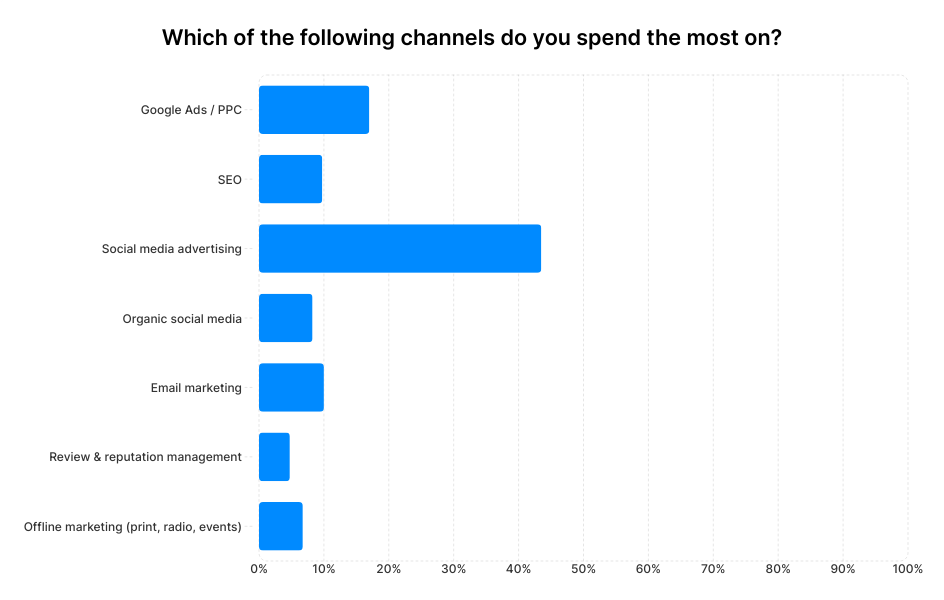
This reliance on paid social reflects where consumers spend their time.
However, it may also signal short-termism, as organic search and reviews often drive more durable long-term growth.
Why It Matters
Paid social offers immediate visibility, but it’s also volatile. Algorithms change, costs fluctuate, and ads stop delivering the moment budgets run dry.
Overreliance creates vulnerability, leaving businesses exposed if ad performance suddenly drops or budgets need to be cut.
Without complementary long-term investments in channels like SEO, email, or reviews, businesses may find themselves trapped in a cycle of constantly paying for visibility without building lasting equity.
Recommendation
Balancing ad spend with investments in owned assets like SEO, email, and reviews creates greater long-term stability.
Paid ads can drive immediate visibility, but channels that a business owns and controls provide resilience over time.
Diversifying into areas that compound value (such as search visibility, a growing email list, and a strong base of customer reviews) builds a foundation that continues to generate leads even when ad budgets fluctuate.
6. Social Media Ads Also Drive the Highest ROI
Not only do social media ads dominate spending, they also dominate perceptions of ROI.
Four in ten SMBs say paid social delivers the highest return, compared to 16% for PPC, 13% for SEO, and 11% for organic social.
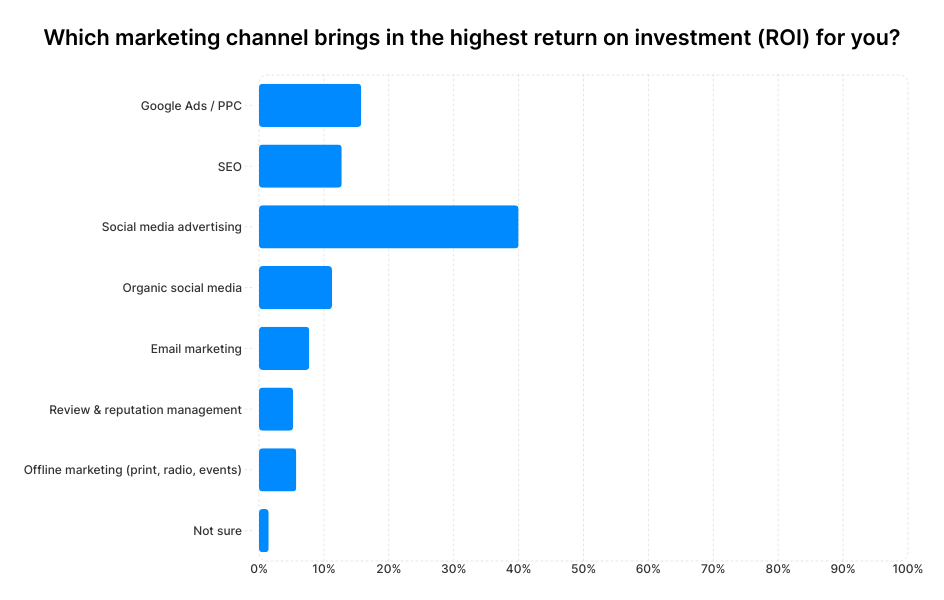
While this aligns with budget allocation, it raises questions about measurement accuracy. Paid ads are easier to track in the short term, while channels like SEO and reviews deliver compounding benefits that may be harder to quantify.
Why It Matters
What businesses perceive as high ROI may reflect ease of measurement rather than true profitability.
This bias can skew investments toward short-term wins over long-term growth.
Channels like paid ads often show immediate, trackable results, while slower-building strategies such as SEO, referrals, or reputation management may deliver higher value over time but are harder to attribute directly.
Focusing only on what’s easiest to measure risks underinvesting in the foundations that sustain growth.
Recommendation
Adopting multi-channel attribution models or even simple tracking methods helps capture leads from SEO, referrals, and reviews, not just paid ads.
Basic tools such as call tracking, unique promo codes, or simply asking customers how they found the business can reveal the true impact of different channels.
Looking beyond last-click ROI gives businesses a clearer picture of lifetime value and supports smarter long-term investment decisions.

Manage online reviews with ease
Monitor, manage, and get more online reviews for your business with ReviewsOnMyWebsite.
7. Sales and Revenue Are the Top Success Metrics
When measuring success, 64% of businesses point to sales or revenue as their primary metric.
Website traffic (43%) and leads (37%) follow, while only 30% track reviews and 29% track calls or inquiries.
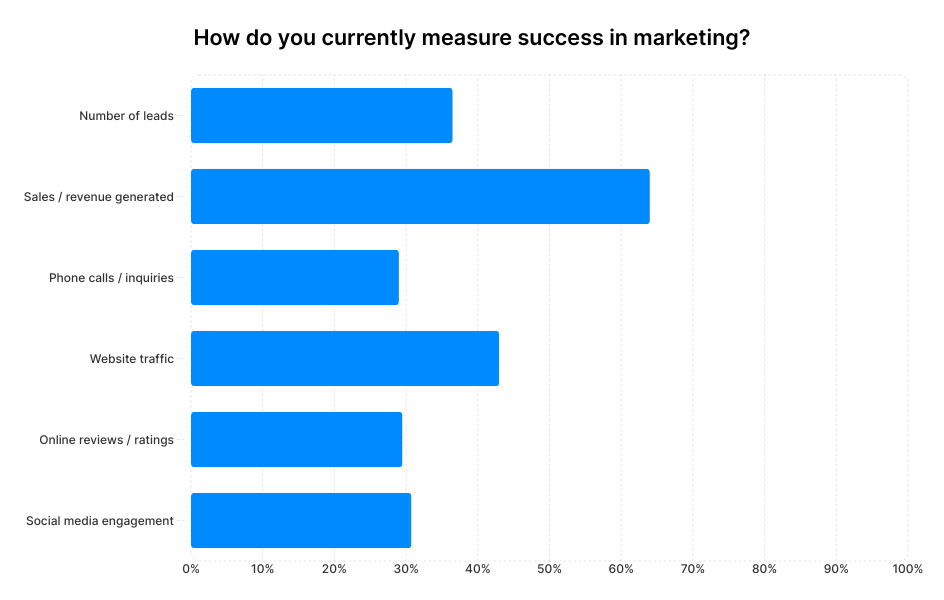
The emphasis on bottom-line results is positive, but the relatively low prioritization of reviews and calls suggests many SMBs undervalue trust-building and offline conversions.
Why It Matters
Focusing only on sales obscures the inputs that drive them.
Reviews, calls, and inquiries are leading indicators. Ignoring them makes it harder to optimize early in the funnel.
When businesses track only final sales, they may miss signals that reveal whether their marketing is attracting the right audience, building trust, or generating interest.
Monitoring these earlier touchpoints creates opportunities to make adjustments sooner, improving conversion rates and reducing wasted spend.
Recommendation
Businesses should track a balanced scorecard of outcomes (like sales and revenue) alongside signals that drive those outcomes (such as reviews, leads, and calls).
Looking only at final sales makes it hard to spot issues early, while monitoring both outcomes and signals provides a clearer view of the full customer journey.
Even a simple dashboard or spreadsheet can help small businesses connect the dots between trust-building activities and bottom-line results.
8. Most Business Owners Are Confident in Their Marketing ROI
Confidence in marketing ROI is high: 62% are very confident, 33% are somewhat confident, and only 5% are not confident. Virtually no respondents said they don’t track ROI.
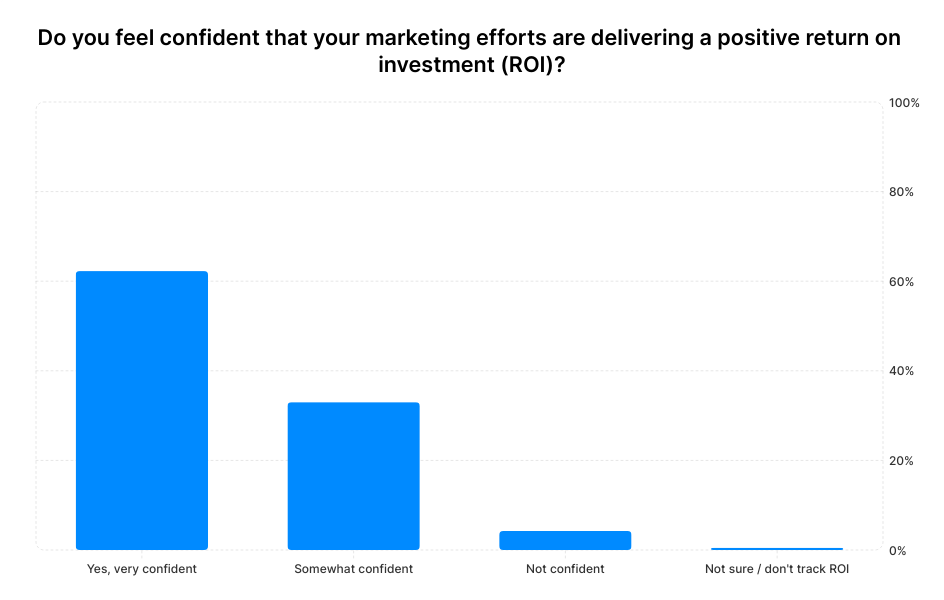
This optimism may be partly justified, but it also raises the risk of overconfidence, particularly since earlier findings showed that ROI tracking itself is often a major challenge.
Why It Matters
Perceived ROI doesn’t always equal actual ROI. High confidence without strong tracking can lead to complacency and misallocated budgets.
When decisions are based on gut feeling rather than reliable data, businesses may double down on channels that feel effective but aren’t truly delivering results.
Over time, this disconnect can slow growth and make it harder to justify marketing spend when budgets come under pressure.
Recommendation
SMBs should validate their confidence with clear ROI frameworks, even simple ones.
This could mean setting up basic tracking for leads, calculating customer acquisition costs, or comparing marketing spend to revenue growth over time.
By grounding confidence in actual data, businesses can avoid blind spots and make more informed decisions about where to increase, reduce, or reallocate their marketing budgets.
9. Budget and Competition Are the Top Challenges
Asked about their biggest marketing challenges, 23% cited limited budgets, 20% said standing out from competitors, and 15% mentioned tracking ROI or keeping up with trends.
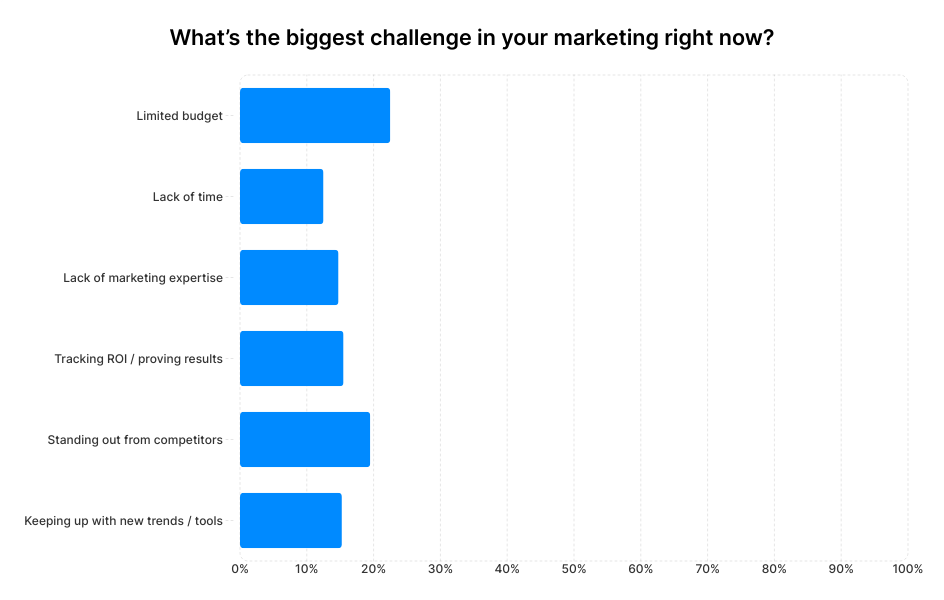
These results highlight the dual challenge of limited resources and competitive intensity.
Small businesses are aware of their constraints but often lack the tools or expertise to overcome them.
Why It Matters
Budget and competitive pressure are perennial SMB struggles. Without differentiation and efficient spend, businesses risk becoming commoditized in crowded markets.
Competing only on price or availability often forces margins down and makes long-term growth unsustainable.
By contrast, businesses that invest in standing out through service quality, brand reputation, or customer trust signals like reviews are better positioned for success.
These businesses can command loyalty, differentiate themselves more clearly, and avoid getting lost in the noise of crowded markets.
Recommendation
Focusing limited resources on differentiation and building customer trust is often more effective than trying to outspend competitors.
Highlighting unique strengths, delivering consistent service, and showcasing authentic customer reviews can create a stronger impact than large ad budgets.
By leaning into what makes them different and reinforcing it with visible trust signals, small businesses can compete more effectively even against larger players.
10. Most Update Their Website Monthly or Weekly
Nearly 35% update their websites monthly, and 31% update them weekly. A quarter update quarterly, while only 8% update annually or less.
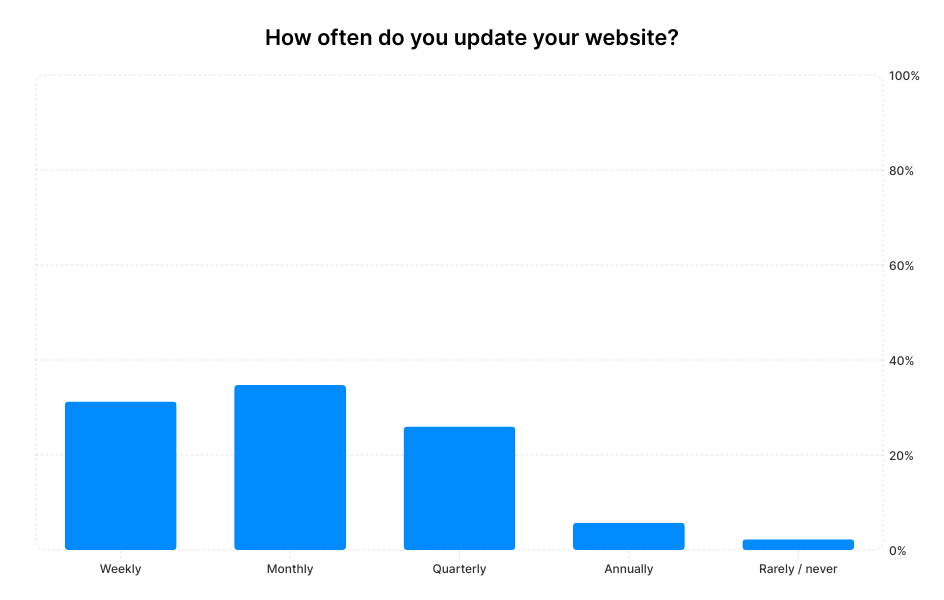
Frequent updates show that small businesses understand the importance of keeping their digital presence current.
However, “updates” may range from minor content changes to more substantial optimizations.
Why It Matters
A stale website erodes trust and signals neglect to both customers and search engines. Frequent updates, when meaningful, improve visibility and credibility.
Fresh content shows customers that the business is active and engaged, while also giving search engines more signals to index and rank.
Over time, these updates can compound into stronger online visibility, higher customer confidence, and more opportunities to convert visitors into paying customers.
Recommendation
Keeping a website current requires more than cosmetic updates. Regularly adding new content, highlighting recent reviews, and updating service details helps maintain both customer trust and search visibility.
Businesses that treat their site as a living asset rather than a static brochure are more likely to attract repeat visits and convert new customers.
Even small, consistent improvements compound over time into a stronger digital presence.
11. Online Reviews Are Extremely Important for Customer Acquisition
The vast majority of SMBs view reviews as essential: 48% say they are extremely important and 38% say very important. Only 2% consider reviews unimportant.
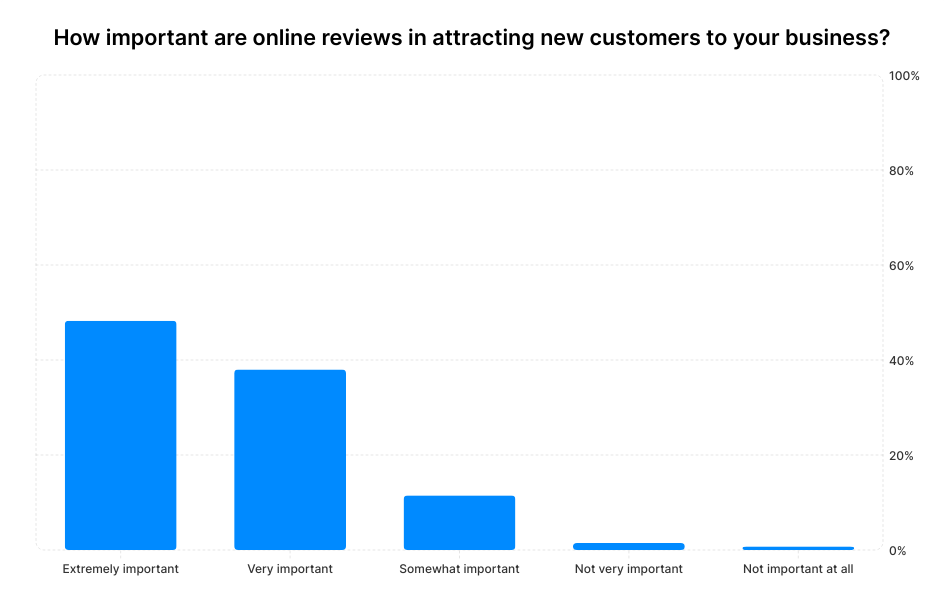
This reinforces what other studies have shown: online reputation is one of the most powerful levers of trust and conversion.
Why It Matters
Reviews are often the first impression customers see. Without strong ratings and recent reviews, even the best-run businesses risk losing leads before first contact.
Prospective customers may never click through to a website or make a call if they see outdated or negative feedback.
Consistently generating fresh, positive reviews ensures that businesses stay competitive in local search results and win trust at the very first step of the customer journey.
Recommendation
A strong review strategy depends on consistency. Small businesses can strengthen trust and attract new customers by:
- Setting up review monitoring: Keep track of new reviews across platforms so nothing slips through the cracks. You can use ReviewsOnMyWebsite to read all the reviews you get across different platforms from one central location.
- Replying to all reviews: Acknowledge both positive and negative feedback to show customers you value their input. Speed up replies with AI-powered responses.
- Automating review requests: Use simple systems to ask for feedback after every purchase or service, ensuring a steady flow of new reviews. ReviewsOnMyWebsite lets you create automated email and SMS review request sequences to ensure every customer is asked to leave a review.
- Showcasing reviews: Feature testimonials on your website and social media. This is easy to do with ReviewsOnMyWebsite's review widget and social sharing features.

Manage online reviews with ease
Monitor, manage, and get more online reviews for your business with ReviewsOnMyWebsite.
12. Businesses Prefer All-in-One Marketing Platforms
Half of SMBs (50%) prefer using an all-in-one marketing platform, while 38% prefer specialized tools. A small minority (11%) have no preference.
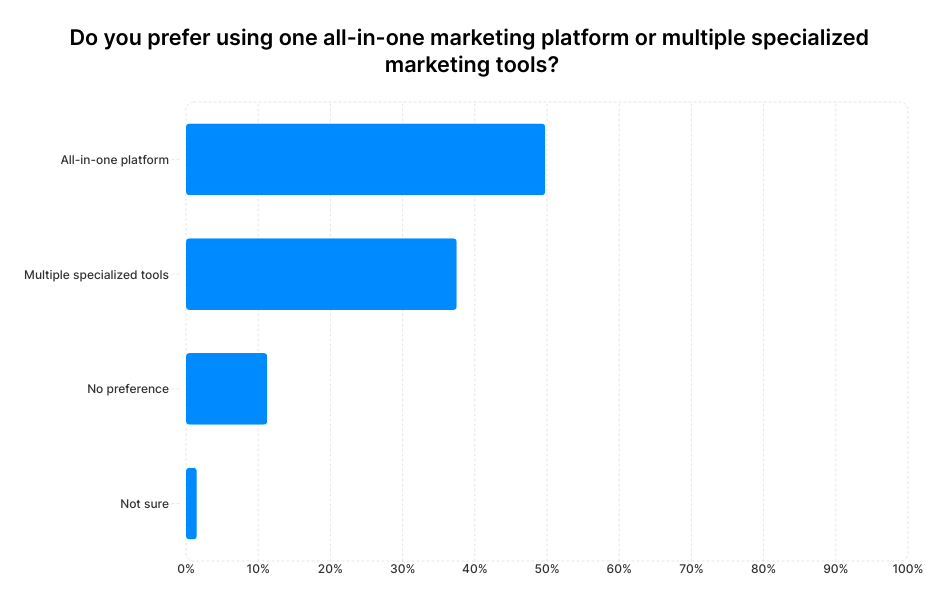
This reflects a desire for simplicity and efficiency, particularly among owners who manage marketing themselves.
Why It Matters
SMBs often lack the bandwidth to manage multiple point solutions. Platform fatigue can undermine adoption, even if specialized tools are technically superior.
Constantly switching between different logins and dashboards eats into valuable time and increases the likelihood that important tasks will slip through the cracks.
Over time, this complexity can discourage consistent execution, leaving businesses underutilizing the very tools they invested in.
Recommendation
Choosing marketing tools that are easy to use and integrate smoothly with existing systems is essential for small businesses with limited time and technical resources.
An all-in-one platform can simplify day-to-day tasks and reduce the need to juggle multiple logins and dashboards.
By prioritizing simplicity and usability, business owners can save time, avoid tool fatigue, and focus more energy on serving customers.
13. AI Has Already Hit the SMB Mainstream
AI adoption has accelerated dramatically. A majority (52%) use AI tools like ChatGPT regularly, and another 32% use them occasionally. Only 4% say they’re not interested.
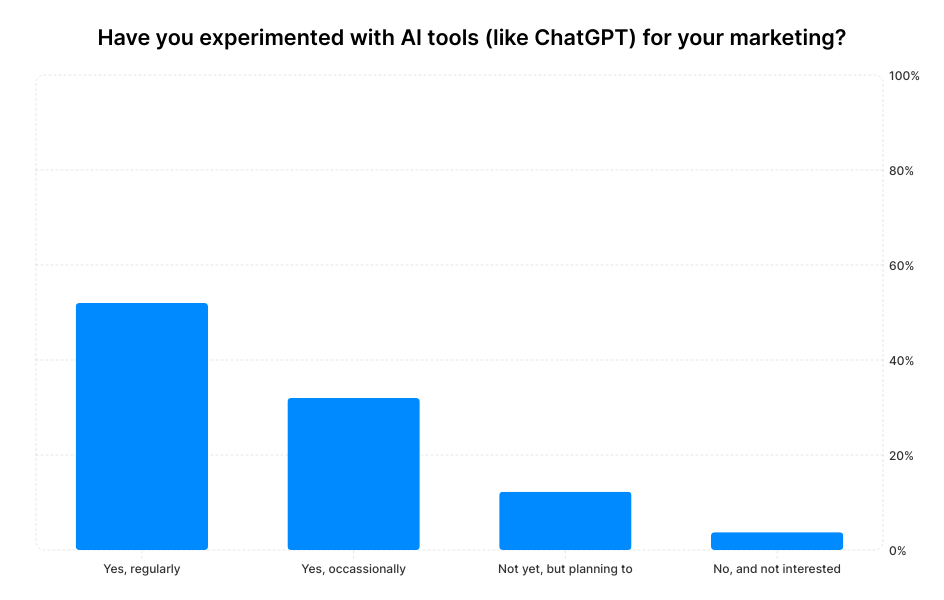
This finding suggests that AI has crossed into mainstream use among small businesses, reshaping how they produce content, manage campaigns, and even respond to reviews.
Why It Matters
AI adoption changes the playing field. Businesses that use it can move faster and reduce costs, widening the gap with competitors that resist change.
Early adopters are already streamlining tasks like content creation, customer communication, and data analysis, giving them an efficiency advantage that compounds over time.
Those who delay risk falling behind as customers begin to expect quicker responses, more personalized experiences, and consistent online engagement powered by AI-driven tools.
Recommendation
Experimenting with AI in low-risk areas like content generation, ad copy testing, and review responses can help small businesses gain efficiency without overhauling their entire marketing approach.
Starting small reduces risk and allows owners to see where AI delivers real value.
Over time, these experiments can grow into broader adoption, saving time, lowering costs, and making marketing efforts more scalable.
14. Social Media Ads Will See the Biggest Future Investment
Looking ahead, 35% of SMBs expect to increase investment in social media advertising, compared to 23% in PPC and 13% in SEO.
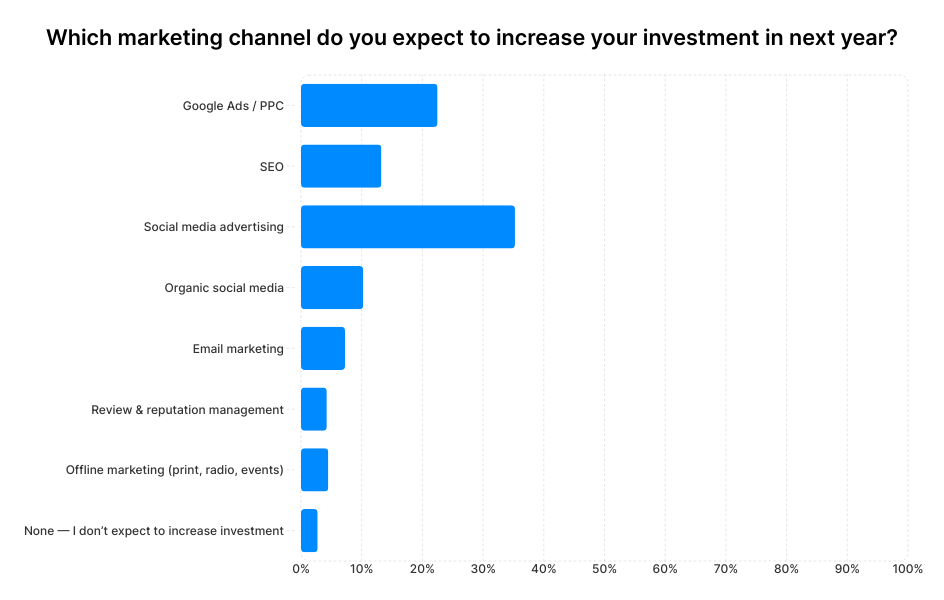
Organic social, email, and reviews are secondary priorities.
This forward-looking trend confirms the dominance of social media ads and highlights potential blind spots, as businesses underinvest in organic growth drivers like SEO and reviews.
Why It Matters
Heavier dependence on ads could inflate acquisition costs and reduce resilience. Businesses that fail to diversify risk being at the mercy of ad platforms.
Rising costs, stricter targeting rules, or sudden algorithm shifts can quickly erode results, leaving little control in the hands of the business.
By contrast, those that balance ads with organic strategies like SEO, email, and reviews build a more stable foundation that continues to generate leads even when paid performance fluctuates.
Recommendation
Balancing growth from ads with steady investment in organic channels creates a more resilient marketing mix.
Paid social can deliver quick wins, but long-term success comes from assets that build over time—such as SEO visibility, an email list, and a strong base of customer reviews.
By diversifying their efforts, small businesses reduce reliance on ad platforms and create a foundation that continues to generate leads even if budgets tighten or algorithms change.
15. Most Are Confident About Hitting Next Year’s Goals
Optimism is strong: 56% are very confident and 40% are somewhat confident they’ll hit their marketing goals in the coming year. Only 5% express doubt.
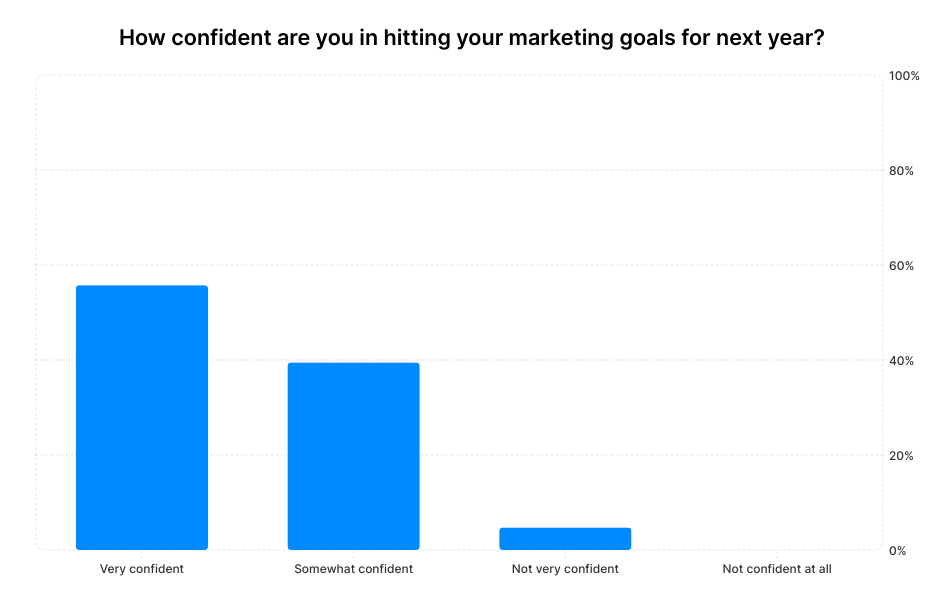
This upbeat outlook contrasts with the challenges cited earlier, suggesting that small businesses are resilient and ambitious but may underestimate the competitive and resource hurdles ahead.
Why It Matters
Confidence drives ambition, but overconfidence can blind businesses to risks. Pairing optimism with realism is key for sustainable growth.
Without grounding expectations in data and clear performance metrics, businesses may overlook warning signs until it’s too late to correct course.
Balancing a positive outlook with accountability ensures that confidence becomes a driver of progress rather than a source of complacency.
Recommendation
Optimism about hitting marketing goals is valuable, but it needs to be grounded in measurable actions.
Defining clear KPIs (such as lead volume, conversion rates, or review growth) and holding the business accountable to them ensures confidence translates into progress.
Tracking these indicators over time helps owners spot when they’re on track and when adjustments are needed, turning optimism into a structured path toward results.
Over to You
Small businesses are investing seriously in marketing, with most maintaining written strategies, dedicating meaningful budget percentages, and embracing new tools like AI.
At the same time, challenges such as limited budgets, competitive pressure, and overreliance on paid ads remain significant hurdles.
Reviews and reputation stand out as critical trust signals, yet many businesses still treat them as secondary compared to sales or ad performance.
To translate these findings into action, you can start with a few practical steps:
- Document and review your strategy: Even a short written plan tied to revenue goals helps bring clarity and alignment.
- Balance short- and long-term investments: Pair quick wins from paid ads with compounding channels like SEO, reviews, and email.
- Strengthen your digital presence: Keep websites fresh, active, and trustworthy with regular updates and visible customer feedback.
- Adopt simple ROI tracking: Use basic tools to measure where leads come from and validate which channels deliver sustainable returns.
- Make reviews a habit: Monitor feedback, reply consistently, and automate review requests to keep trust signals strong.
- Experiment with AI carefully: Start with low-risk areas such as content generation or review responses, then scale based on results.
Small businesses that act on these steps will be better positioned to compete, earn customer trust, and sustain growth.



